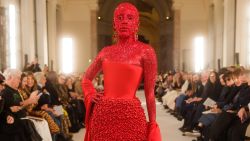Editor’s Note: This article was originally published in April 2016.
Story highlights
London's V&A museum has launched an exhibition on the history of underwear
With over 200 pieces -- from the 18th century to present day -- it is the largest of its kind
Sarah Shotton is creative director of British lingerie brand Agent Provocateur, a key sponsor of the event
Why do we wear underwear? Whether for health, hygiene, sensory or fashionable purposes, the evolution of our undergarments is one that directly links with cultural changes in society.
Despite this our bras, underpants and boxer shorts are still regarded as “unmentionables,” rarely discussed. Perhaps because even the most practical of pieces can’t help but be imbued with eroticism.
Lacy garments reflect societal changes
A new exhibition at London’s Victoria and Albert Museum focuses on this unseen history.
The largest of its kind, with over 200 pieces from the 18th century to present day on display, Undressed: A Brief History of Underwear examines the links between underwear and fashion and the ways that changes in fit, fabric and technology have often reflected society’s attitudes to gender, sexuality and morality.
Undressed: A Brief History of Underwear
Arranged thematically with sections that focus on, for example, performance underwear (such as maternity or activewear), luxury lingerie and underwear in fashion, there’s everything from bustles and corsets to thongs and yoga outfits.
There are pieces worn by Gwyneth Paltrow, Kate Moss, Dita Von Teese and even Queen Victoria’s mother.
The link to fashion is clear, with pieces by designers including Jean-Paul Gaultier, Vivienne Westwood, Stella McCartney and Paul Smith.
Lingerie brand pushes boundaries
British lingerie brand Agent Provocateur is one of the key sponsors of the exhibition.
Launched in 1994 by Joseph Corre and Serena Rees, the brand has been in many ways, a revolutionary force in British underwear, by providing a sexy, high-end alternative in what was once a very limited market.
Now a global brand, collaborating with the likes of Kylie Minogue, Penelope Cruz and Paloma Faith, their items are known for being both provocative and empowering.
Creative director Sarah Shotton explains, “when Agent Provocateur opened in 1994 that was a big turning point for lingerie, because at the time in the UK there was Marks & Spencer or there was Ann Summers, there was nowhere like Agent Provocateur. They made it all right for you to go out clubbing in your bra.”
Shotton has been with the brand since 1999, when she herself started out working in the first shop. Having studied fashion at Central Saint Martins, she grew with the company, moving into her current position in 2010.
She explains the role of underwear, and particularly lingerie, to women now and how the launch of this prominent exhibition at the V&A is indicative of society’s wider attitudes.
“Only 25 years ago we didn’t really talk about sex, people were quite prudish. Lingerie was more about your little secret. I think that is how it’s changed. It’s saying that this is something we should be celebrating.”
“Undressed: A Brief History of Underwear” is open from 16 April 2016 to 12 March 2017 at the Victoria and Albert Museum London
Video by CNN’s Holly Vear





































